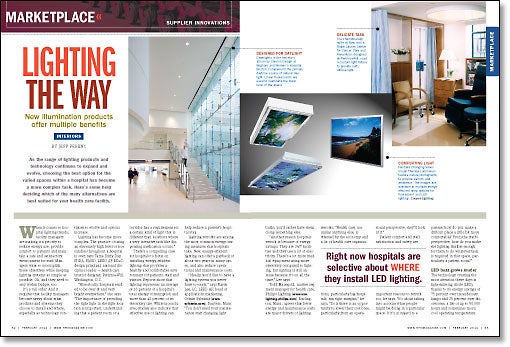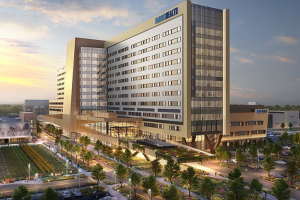Lighting the way

As the range of lighting products and technology continues to expand and evolve, choosing the best option for the varied spaces within a hospital has become a more complex task. Here's some help deciding which of the many alternatives are best suited for your health care facility.
When it comes to hospital lighting trends, facility managers are making it a priority to reduce energy use, provide comfort to patients and maintain a safe and satisfactory environment for staff. Managers want to accomplish these objectives while keeping lighting systems as simple as possible. Oh, and they need to stay within budget, too.
It's a tall order. And it requires that facility managers become savvy about what products and systems they choose to install and where, especially as technology continues to evolve and options increase.
Lighting has become more complex. The practice of using an extremely high level of foot candles throughout a hospital is over, says Tama Duffy Day, FIIDA, FASID, LEED AP BD+C, design principal, national discipline leader — health care interior designer, Perkins+Will, Washington, D.C.
"Historically, hospitals tended to be over-lit and very bright everywhere," she says. "The importance of providing the right light in the right location is important, understanding that a patient room or a corridor has a requirement for a certain kind of light that is different than locations where a very intensive task like dispensing medication occurs."
There's a compelling case for hospitals to focus on installing energy-efficient lighting that provides a healthy and comfortable environment for patients, staff and visitors. Reports show that lighting represents an average of 16 percent of a hospital's total energy consumption and more than 40 percent of its electricity use. While inconclusive, studies also indicate that effective use of lighting can help reduce a patient's hospital stay.
Lighting retrofits are among the most common energy-saving measures that hospitals take. New, energy-efficient lighting can offer a payback of about two years in many cases, and also reduce operational and maintenance costs.
"Ideally, you'd like to have a lighting system you never have to touch," says Karen Lee, LC, LEED AP, head of applications marketing, Osram Sylvania (www.sylvania.com), Danvers, Mass. "You don't need your maintenance staff changing light bulbs; you'd rather have them doing something else.
"Another reason hospitals retrofit is because of energy savings. They are 24/7 facilities and they use a lot of electricity. There's a lot more medical equipment using more electricity compared to lighting, but lighting is still an issue because it's on all the time," Lee says.
Todd Manegold, market segment manager for health care, Philips Lighting (www.usa.lighting.philips.com), Burlington, Mass., agrees that lower energy and maintenance costs are major drivers of lighting retrofits. "Health care, not unlike anything else, is stressed by the economy and a lot of health care organizations, particularly big hospitals, run tight margins," he says. "So if there is an opportunity to lower their cost base, particularly from an operational perspective, they'll look at it."
Patient comfort and staff satisfaction and safety are important reasons to retrofit too, he says. "It's about taking into account what people might be doing in a particular space. If it's in regard to a patient, how do you make a difficult place a little bit more comfortable? From the staff's perspective, how do you make the lighting flexible enough for them to do whatever task is required in that space, particularly a patient room?"
LED buzz grows louder
The technology creating the most attention these days is light-emitting diode (LED), thanks to its energy savings of 75 percent over incandescent lamps and 25 percent over fluorescent; a life of up to 50,000 hours and sometimes more; cool operating temperature; and excellent controllability.
Despite its multiple benefits, most hospitals so far are still cautiously evaluating LED and some are installing it in limited applications when they do choose this option, experts say. LEDs can cost from five to 10 times more than fluorescents and sometimes suffer from a reputation, deserved or not, of being unreliable due to early versions of the technology.
Still, lighting experts agree LED is here to stay and its use will become more common. Susana Babic, associate AIA, IESNA, LEED AP, a principal and designer at lighting manufacturer rep firm ICON, located in Washington, D.C., believes LED represents a growing trend in hospital lighting.
"Hospitals are installing LED more frequently," says Babic. "We are retrofitting slowly — as much as we can. Everybody knows about the advantages. Even though budgets are really tight, hospitals try to include it as much as possible."
Right now, health facilities are selective about where they install LED. Babic says hospitals are not installing LED in common areas requiring general illumination like corridors, where fluorescent lamps are still the lighting of choice. Instead, hospitals generally install LED in spaces such as nurses' stations, waiting rooms and, to a lesser extent, patient rooms, she says.
According to the Department of Energy (DOE), other common applications include parking areas, exit signs, under-cabinet lighting, adjustable task lighting, accents lights, and step and path lighting.
"The trend now is toward LED, everyone wants LED everything," says Manegold of Philips Lighting. "Our response to that is LED is appropriate for the right spaces. To install a high-output LED fixture may not make the perfect business case at this point. We're very cognizant of where it should be used and where it might be better to use traditional fluorescent technology."
Tom Lane, marketing director — health care, Cooper Lighting (www.cooperlighting.com), Peachtree City, Ga., says LED applications in health care facilities are slow going so far because facility managers are playing it safe. "They might be a little cautious at this stage of the game," he says. "Budgets have something to do with it, for sure. But certainly even if it wasn't money, delaying the use of LED is a case of waiting around a little bit to get a better feeling from a reliability standpoint."
Jon Cooper, CEO and president, NexPhase Lighting (www.nexphaselighting.com), Coral Springs, Fla., whose company makes intelligent LED fixtures, sees a bright present and future for LED. "Clearly, LED is here and we've passed the tipping point," he says.
"It is a much more efficient lighting solution than what hospitals are currently using. It is clearly the future of lighting for hospitals in an economic sense from the energy cost savings, lifespan and maintenance perspectives," Cooper says. "But it also can reduce medical errors, increase staff effectiveness and support more positive patient outcomes."
Cooper touts LED's unique intelligence and control capabilities and the fact that private financing can pay for the total cost out of a percentage of energy savings with little or no up-front costs. The expansion of utility and governmental incentives can further reduce the cost barrier. Others also believe that as the technology evolves and pricing drops, hospitals will use LED more frequently.
Perhaps, but LED is not the proverbial silver bullet of lighting solutions. "LED is not a one-size-fits-all kind of approach," Manegold says. "You have to understand what the space is being used for, who's using that space and what's important to them. You decide your lighting solution based on that."
The power of less light
Installing high-efficiency T8 fluorescent lamps and electronic ballasts are common, tried-and-true lighting retrofit strategies along with occupancy sensors and dimming devices. Daylight harvesting and daylighting are other ways to save energy and create a healthy space.
Lane says an easy way to cut 10 percent of a lamp's energy use is to change out a 32-watt T8 fluorescent lamp for a 28-watt version without replacing fixtures or ballasts. According to DOE, replacing older T8 and T12 fluorescent lamps with high-efficiency T8 lamps and electronic ballasts can reduce energy usage by 20 to 30 percent.
Occupancy and now vacancy sensors offer additional opportunities to save energy. Tom Myers, director of commercial real estate solutions, Lutron Electronics Co. (www.lutron.com), Coopersburg, Pa., says installing room sensors are the "simplest- and easiest-to-retrofit controls you can bring into a hospital."
Vacancy sensors offer a 46 percent energy savings potential over occupancy sensors, which already cut energy use up to 60 percent depending on the space where it's installed, according to Lutron. Vacancy sensors offer additional energy savings because they require that a light be turned on manually when a space is occupied as opposed to occupancy sensors that turn a light on whether it's needed or not, Myers says.
Daylighting and daylight harvesting offer ways to reduce energy while also contributing to a healing environment. Daylighting typically maximizes use of natural light to reduce artificial light use and is more commonly incorporated in new construction, Myers says.
Daylight harvesting, or control, adds the use of sensors to automatically adjust lighting in response to the level of daylight in a space. Lutron offers an easy-to-install, plug-and-play product for hospitals that requires no electrical rewiring or sophisticated commissioning, Myers says.
A contractor installs a half dollar-sized sensor near the window of the space being retrofit and a shoebox-sized controller into the ceiling plenum to operate lighting in a space or small group of spaces, Myers says. The system saves from 50 to 75 percent of lighting electricity.
Daylight harvesting is an excellent technology for hospital lobbies, especially since the trend is toward the installation of large windows in that space, says Lee of Osram Sylvania. The system could be used in corridors if the hallways are located in or near a space where natural light is available, she says.
Another design and technology trend is to install fixtures that give patients more control over lighting levels, while still giving medical staff the ability to increase lighting when needed. Holly English, sales and marketing director, Healthcare Lighting (www.healthcare-lighting.com), Fairview, Pa., says her company and others offer fixtures that provide multiple light levels to increase patient control and comfort while still allowing clinical staff to provide caregiving.
"We build our controllers to allow the patient to have multilevel switching," she says. "It allows the patient to choose whatever light level they find most comfortable. That's a key element of our design in that every patient is going to need a different light level for reading or for ambient illumination."
As hospital lighting gets better and continues to evolve, everyone benefits — from patients to the medical staff to family and visitors, says Duffy Day of Perkins+Will.
"Lighting helps with wayfinding, it helps with health, it affects your mood, it reduces medical errors, it can reduce depression," she says. "I think lighting is one of the most important tools that we have and that we use in successful buildings." HFM
Jeff Ferenc is senior editor for Health Facilities Management magazine.
| Sidebar - For more information |
| For further details on the lighting products discussed in this month's "Marketplace" article, readers can contact the following vendors: »Arch Lighting Group Inc. »Cooper Lighting »Healthcare Lighting »ICON »Lutron Electronics Co. »Osram Sylvania »NexPhase Lighting Inc. »Philips Lighting |




